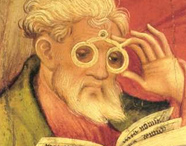
How Better Seeing Came to Being, Part 2
Didn’t read Part 1? Click here!
In 1752 James Ayscough advertised spectacles with double hinged side pieces. These became extremely popular and appear more often than any other kind in paintings, prints, and caricatures of the period. Lenses were made of tinted glass as well as clear. Ayscough felt that “white glass gives an offensive glaring light, very prejudicial to the eyes, and on that account, green and blue glasses have been advised…”. In Spain Pablo Minguet recommended turquoise, green, or yellow lenses but not amber or red.
European men and women, particularly the French, were self-conscious about wearing glasses. Parisian aristocrats used reading aids only in private. The gentry of England and France used a “perspective glass or monocular which could be hidden from view easily”. In Spain, however, spectacles were popular among all classes because people thought glasses made them look more important and dignified.
Far-sighted and aging colonial Americans imported spectacles from Europe. Spectacles were mainly for the affluent and literate colonists: glasses cost as much as $200 in the early 1700’s.
John McAllister, Sr. opened his store in Philadelphia somewhere between 1783 and 1799 with “a bushel basketfull” of spectacles, through which presumably his customers could pick and choose.
In the 1780s Benjamin Franklin developed the bifocal. Later he wrote, “I therefore had formerly two pairs of spectacles, which I shifted occasionally, as in traveling I sometimes read, and often wanted to regard the prospects. Finding this change troublesome, and not always suffficiently ready, I had the glasses cut and a half of each kind associated in the same circle. By this means, as I wear my own spectacles constantly, I have only to move my eyes up or down, as I want to see distinctly far or near, the proper glasses being always ready.” Evidently the idea of bifocals had already been experimented with in London as early as 1760 (possibly by Franklin himself, who was there at the time) though never used extensively.
Before the War of 1812, McAllister imported all the eyeglasses sold in his optical shop. Due to the trade embargo with Great Britain, he began making his own eyeglass frames in 1815.
In 1801, Thomas Young discovered the disability of astigmatism and is the first to map the normal visual field. In 1821, royal astronomer and mathematician George Biddell Airy designed glasses with a spherocylindrical lens to correct astigmatism. McAllister began to import these lenses into his shop in the U.S.
There were over 300 eyeglass retailers in the United States during the 1820s and 1830s. In light of the success of the McAllisters, eyeglass production developed rapidly. Companies diversified their product lines which resulted in products such as telescopes, binoculars, and microscopes.
Excerpted from here, here and here
*****
The M&S Smart System Computerized Vision Testing system is the top choice for the forward-thinking eye care professional. Ask if your eye doctor has our system and, if not, tell them about the Smart System from M&S!
Have a thought about this article? Contact Us and let us know.